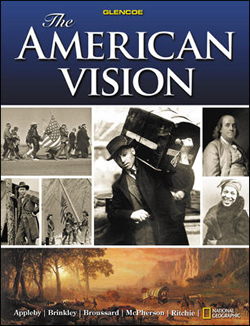The American Vision © 2008Chapter 8:
Sectional Conflict IntensifiesWeb Lesson PlansIntroduction
Students have read about how sectional conflicts tested the new United States government and pushed it toward civil war. In this activity students will take a closer look at what some people argue was the staging ground for the first battles of the Civil War—“Bleeding Kansas.”
Lesson Description
Students will use information from the PBS Web site to learn about the conflict between pro- and anti-slavery factions in Kansas. Students will answer four questions about the material on the site and then apply this information by drafting a proposal for a peaceful resolution to the crisis in Kansas.
Instructional Objectives- Students will explain the sectional differences that surfaced during the debates of the Kansas-Nebraska Act.
- Students will be able to use this knowledge to draft a proposal for resolving the conflict in Kansas.
Student Web Activity Answers- Northerners were outraged because Douglas’s proposal—to decide the slavery question by popular sovereignty—would repeal the Missouri Compromise of 1820, which stated that slavery could not extend north of the 36º30’N parallel. Douglas’s proposal would open the North to slavery.
- Even though Bridgman aligned himself with the free state men, he writes that the murder of five pro-slavery men was “barbarous and inhuman.” He finds it difficult to understand how their motives could be considered good ones.
- Kansas represented the opportunity for individual land ownership.
- Horton explains that many whites who opposed slavery in the territories did so not for moral reasons, but because they did not want to have to compete for land with slaveholders, slaves, or free blacks. If a territory was free of slavery, it would also likely have a very small, insignificant black population.
- Students’ proposals will differ.
 | 




